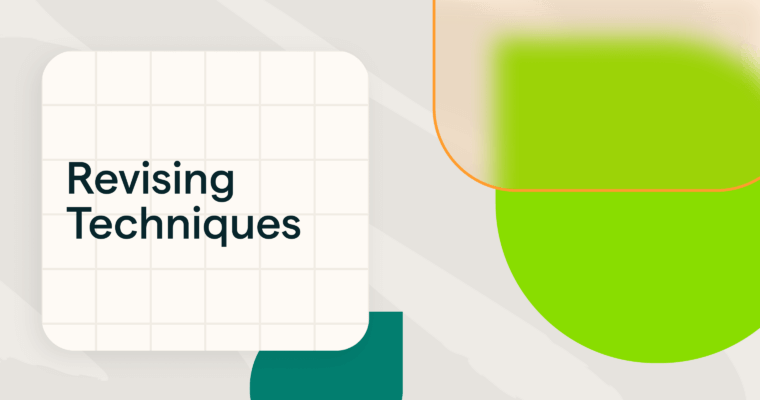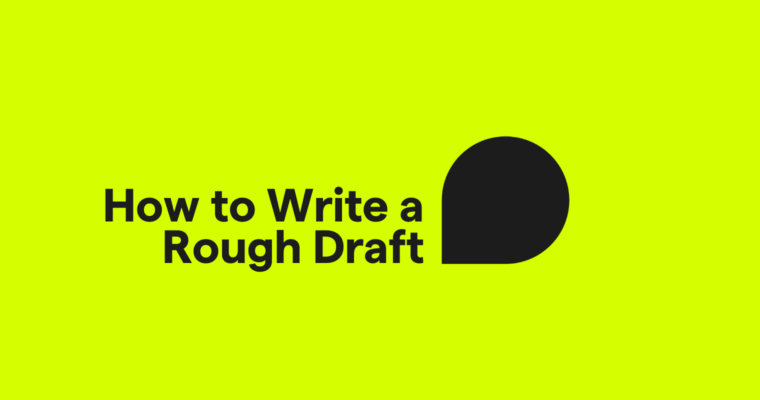
You’ve probably heard the saying “good writing is rewriting.” It means good writing requires coming up with ideas, reviewing and organizing them, putting them into a cohesive written work, revisiting your work, editing it, and revising it to make your words stronger. These steps are known as the writing process.
No matter what you’re writing, whether it’s a blog post, a screenplay, a research paper, or a book review, you’ll work through the writing process to turn your rough ideas into a polished, publishable finished piece. Read on to learn more about the writing process’ six steps in detail.
Brainstorming
The writing process actually starts before you put pen to paper or fingers to keyboard. The first step is brainstorming.
Depending on the assignment, you may be given a topic or you may have to create one yourself. Do an internet search for the topic you’ll be covering to get a stronger grasp on it and all the potential directions your writing can take.
When you brainstorm, you think deeply about the topic you’ll be covering in your writing and let your mind follow any and every lead it comes across. If you’ve been assigned to write within a fairly broad area, this is the point where you narrow your topic down to a specific thesis statement.
For example, if you’re writing about key events in American history during the Gilded Age, you could decide to focus on the debate surrounding the gold standard that occurred during that time. As you brainstorm, you might zero in further on how it was portrayed in pop culture and decide to write your essay on how L. Frank Baum’s The Wonderful Wizard of Oz represented this debate through specific imagery.
Jot down every idea you have while you brainstorm, even if it’s only tangentially related to your topic. The goal here isn’t to create a coherent piece of writing—it’s to clear a path for your writing.
Brainstorming isn’t just about developing a clear topic and set of supporting content to cover; it’s about determining the most effective way to present your information to your intended audience. Think about the type of writing you’re doing and whom you’re writing it for. A video script that walks your viewers through a specific knitting technique requires a much different tone, structure, and vocabulary than an academic research proposal for your master’s program in marine biology.
Once you have a clear central theme for your writing and a strong grasp on your supporting arguments, it’s time to finesse your brainstorming results into a logical outline.
Preparing to write
The next step in the writing process is preparing to write. In this stage, you’re taking all the ideas, connections, and conclusions you encountered during your brainstorming session and organizing them into an outline.
An outline is basically a skeleton of a finished piece of writing that maps the topics you’ll cover and where each paragraph fits into the piece. It provides a structure that helps ensure your ideas flow logically and clearly. It can be helpful to look at outline templates online, especially if you’ve been assigned a type of writing that you haven’t done before.
Choosing authoritative sources
At this stage, you’ll also identify which sources to use. With certain types of writing, you’ll need to cite your sources. If this is the case for your current assignment, this stage is the point at which you should familiarize yourself with the applicable style guide and its formatting requirements for citations.
Make sure your chosen sources are appropriate for your writing before you decide to use them. For an academic writing assignment, the range of acceptable sources you can use is typically limited to academic articles, government or nonprofit research groups, and, if you’re writing a literature review, the literary works you’re comparing in your writing. With other kinds of writing, appropriate sources are relevant sources. For example, if you’re writing an article about the rising popularity of mushroom-based health supplements, effective sources may include:
- Sale statistics from retailers
- Insight on mushrooms’ health benefits from accredited health experts (think nutritionists, doctors, and other healthcare providers)
- Data from health-supplement industry journals
Your sources’ job is to support your writing. Working with credible sources gives your writing a strong foundation, while weak sources undermine the position your writing takes.
Striking the right tone
This is also the stage where you clarify the tone you’ll use in your work. Usually, figuring out the right tone for your writing is easy—if it’s an essay or another piece of academic writing, it needs a formal tone. If it’s a promotional piece, your tone needs to be engaging and highlight the benefits of whatever you’re promoting. If it’s a cover letter, your tone should be confident, but not arrogant. When you’re unsure about the right tone to use or how to achieve it, do an internet search for examples of the type of writing you’re doing and familiarize yourself with the structure, vocabulary, and overall tones used.
>>Read More: Grammarly’s Tone Suggestions Help You Tailor Your Tone to Your Reader
Writing your first draft
You’re finally ready to write!
Don’t worry about making your writing perfect just yet—at the rough draft stage, your goal is to get words on the page, not to churn out something that’s ready to publish.
Using the outline you created, start building your draft, sentence by sentence and paragraph by paragraph.
Here’s a secret a lot of writers don’t realize: You don’t have to write your rough draft from start to finish. If you know exactly what you want to say in your third supporting paragraph but you’re not quite sure how to hook readers in your intro, write that third supporting paragraph and come back to the intro later. When you reach a challenging spot in your writing, it’s easy to get stuck there and waste a lot of time trying to figure out what to write. Save yourself the time and stress by writing the easiest parts first, then moving onto the tougher spots.
Doing it this way can also make those tough spots a lot less daunting because it reduces them from big, scary holes to fill up to small blanks to fill in.
Editing and revising
Once you have a completed rough draft, the next step in the writing process is to shape it into a final draft. This is known as editing.
As you move through the writing process, you’ll employ different kinds of editing. At this stage, you’re content editing, line editing, and copy editing. Later, you’ll proofread your work and, depending on the content you’re covering, you might fact-check it as well.
In some cases, you’re totally on your own with editing. In others, editing your work involves incorporating feedback an editor or instructor left on your first draft. When you’re facing the latter scenario, be sure to read the feedback carefully and address or incorporate all of it.
Edit with fresh eyes
Before you edit, give your work time to “cool off.” In other words, don’t jump from writing the first draft to editing it unless you’re crunched for time and you absolutely must. By taking time between writing and editing, you’re giving yourself some distance from your work. This enables you to view it with “fresh eyes” and catch mistakes and areas for improvement more easily than you would if you hadn’t created that distance.
With fresh eyes, look for:
- Logical inconsistencies or fallacies
- Inconsistent and inappropriate tone
- Areas where your writing can be made more concise
- Opportunities to replace words with more effective synonyms
- Confusing phrases and sentences
One way to easily find areas where you can make your writing stronger is to read it aloud. By listening to the rhythm of your writing, you can hear words that feel out of place, awkward transitions, redundant phrases, inconsistent tenses and tone, and points where you need more (or less) detail.
For example, you might find you used language that’s too formal for your blog post that’s making your writing seem stiff and boring. Instead of “the balloon was inflated,” try “we blew up the balloon.”
Or you might find your writing contains redundant phrasing, such as “In my opinion, I think that’s a problem.” Change this to “That’s a problem” to make your writing more direct and concise.
If the piece you’re writing is meant to be read aloud, like a speech or a presentation, this part of the editing process is mandatory.
Pay attention to how effectively your supporting arguments prove and strengthen your thesis statement. Even if the piece you’re writing doesn’t have a formal thesis statement, it has a central theme or argument. The goal of editing and revising your work is to optimize your writing to make that central theme as clear and powerful as possible.
This is also the stage where Grammarly can really help you out. Not only does the Grammarly Editor catch typos and grammar mistakes, but it can also detect your tone and make word choice suggestions based on your specific writing goals.
Once you’re finished editing, it’s time to revise your draft into its final version. This is the process of implementing all the changes you noted during the editing process.
Proofreading your final draft
The last stage of the writing process is proofreading your final draft. At this stage, you’re finished writing, but you’re not quite ready to hand in your assignment.
Proofreading is one last lookover to catch any spelling mistakes, grammar errors, typos, formatting errors, or incorrect structure or syntax. Unless something is egregiously wrong, you’re not changing any of your content—you’re simply double-checking that everything is grammatically correct. Ideally, you have enough time to proofread your work with fresh eyes.
After you’ve proofread your work, give it one last pass through Grammarly. Grammarly can catch any last-minute mistakes that slip past you and help you avoid embarrassing, easily fixable errors in your work.
Publishing your finished work
Your work is ready to be shared with the world!
What it means to publish your work depends on the type of writing you’re doing. If it’s a blog post, a story you’re self-publishing, a video you’ve written and shot, or anything else where you’re the publisher as well as the writer, this stage is essentially you uploading your own work and making it available to others. If you just completed an academic assignment or a commissioned piece for a journal, blog, or another outlet to which you’re a contributor, this step is when you send it off to your professor or editor. Publishing can also mean submitting your work to an academic journal, querying your novel, or delivering a finished piece of content to your client.
No matter what publishing means for your particular piece, take a moment to celebrate. You wrote something and now, people are going to read it.
This article was originally written in 2019 by Jennifer Calonia. It’s been updated to include new information.






